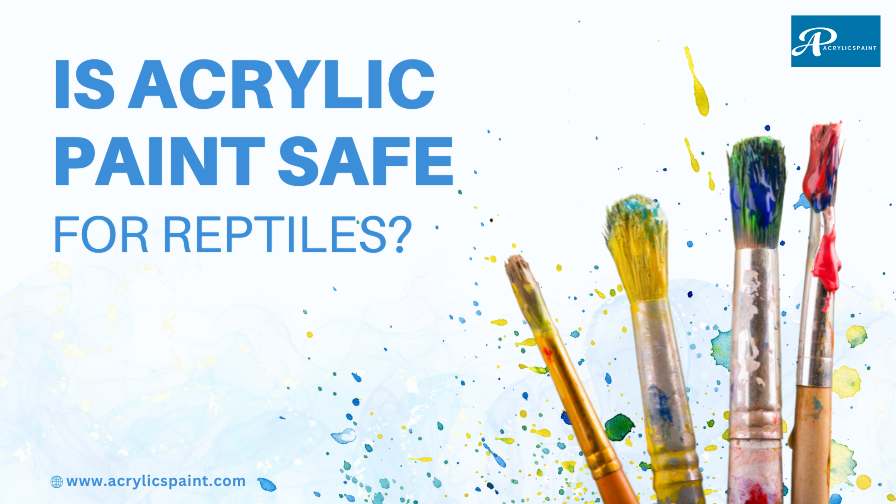Is acrylic paint safe for reptiles? Reptile lovers enjoy creating vibrant and visually appealing environments for their beloved pets. They decorate their pets’ homes with colorful touches, like painting backgrounds or adding accents to hides and décor. These decorations make the enclosure look nice and give the reptile a fun and interesting place to live.
Reptile owners enjoy creating unique and beautiful spaces for their pets with colorful backgrounds and decorations. They take pride in making a special place for their scaly friends. However, safety is a top priority when choosing paint for these environments. One standard option is acrylic paint, but is it safe for reptiles?
Let’s explore the facts and considerations surrounding this topic to ensure the well-being of our scaly friends.
Is Acrylic Paint Safe for Reptiles? Understanding the Risks and Options
The primary concern when using oil paint or acrylic around reptiles is toxicity. Reptiles have sensitive respiratory systems and can be particularly vulnerable to harmful fumes and chemicals. Traditional acrylic paints may contain ingredients that could risk your pet’s health if ingested or inhaled.
1: Is Non-Toxic Acrylic Paint Safe For Reptiles
Safe, non-toxic acrylic paints for humans and pets are also safe for reptiles. These paints are free from harmful chemicals such as heavy metals, formaldehyde, and volatile organic compounds (VOCs). These paints are safe for children and pets and labeled as “AP-certified non-toxic.”
2: Is Liquitex Acrylic Paint Non-Toxic?
Liquitex is a well-known brand in the art community, and many of their acrylic paints are non-toxic. Before painting near your reptile, check the label of the acrylic colors for safety certifications. Ensure that the paint is non-toxic and suitable for reptile habitats.
Choosing Safe Paint for Reptiles
When selecting reptile paint, prioritize non-toxic options labeled as safe paint for reptiles and other pets. Ensure minimal odor and durability to maintain a safe and comfortable environment for your scaly companion. Try using water-based acrylics and give them proper dry time to cure completely.
Factors to Consider
When selecting paint for your reptile’s enclosure, consider the following factors
- Non-Toxicity: Opt for paints labeled as non-toxic to ensure the safety of your pet.
- Odor: Choose paints with minimal odor to avoid causing stress to your reptile.
- Durability: Select paints that are water-resistant and durable to withstand the humid environment of a terrarium.
Potential Risks of Using Unsafe Paint
Unsafe paint near reptiles can cause breathing problems, poisoning, and health issues in the long run. Prioritize your reptile’s well-being by avoiding paints containing harmful chemicals and opting for non-toxic alternatives.
Respiratory Issues
Reptiles, particularly those with delicate breathing systems like snakes and geckos, can be sensitive to airborne toxins. Breathing in paint fumes or swallowing paint can cause trouble breathing and irritation in the respiratory tract.
Skin Irritation
Contact with toxic paint can also cause skin irritation in reptiles. Reptiles may directly contact painted surfaces, especially when exploring their habitat or basking on objects. In severe cases, toxic paint can lead to skin redness, inflammation, or chemical burns.
Ingestion Risks
Reptiles use their tongues to explore; some may eat paint chips or residue while curious. Ingesting toxic paint can lead to stomach issues, poisoning, and other health complications.
Alternatives to Acrylic Paint
If you’re unsure about using acrylic paint or can’t find a safe option, you can try other choices.
- Dry Lock Paint is waterproof and seals surfaces, making it safe for reptile enclosures.
- Aquarium Safe Spray Paint is non-toxic and safe for aquatic and terrestrial animals.
- You can decorate your reptile’s habitat without using paint by using Natural Materials like cork bark, driftwood, or live plants.
Best Practices for Painting Reptile Enclosures
When painting reptile enclosures, prioritize safety using non-toxic paints formulated for animal habitats. Ensure proper ventilation during painting and allow the paint to fully cure before putting your reptile. Regularly inspect and maintain painted surfaces for longevity and safety.
Preparing the Surface
Before painting your reptile’s habitat, ensure the surface is clean and dry. Remove any existing paint or debris that could interfere with adhesion. Sanding the surface lightly can also help the paint adhere better.
Ventilation
Proper ventilation is essential when painting any enclosure. Work in a well-ventilated area, and consider using a respirator mask to minimize inhalation of fumes. Allow painted surfaces to dry thoroughly before putting your reptile to its habitat.
Test Before Use
Before painting your reptile’s home, test a small area first to ensure the paint is safe and works well. Monitor your reptile’s behavior and health after introducing the painted surface to its habitat.
Safety Tips for Reptile Owners
Safety tips are crucial for reptile owners to keep their pets healthy. Regularly check and clean the enclosure to prevent hazards like bacteria buildup. Also, handle reptiles gently and wash your hands before and after touching them to avoid stress or illness. These simple steps ensure a safe and happy environment for your reptile friend.
Monitor Behavior
After painting your reptile’s habitat, closely monitor your pet’s behavior for any signs of distress or adverse reactions. Remove the reptile from its cage immediately. If your pet shows signs like being tired, having trouble breathing, or not eating, bring it to the vet.
Regular Maintenance
Regularly inspect and maintain your reptile’s habitat to ensure that painted surfaces remain intact and free from damage. Touch areas where paint may have chipped or worn away to prevent ingestion or exposure to harmful substances.
Research and Consultation
Before painting your reptile’s habitat, research and ask experienced reptile owners or specialists for advice to ensure success. They can provide valuable insights and recommendations based on their knowledge and expertise.
Conclusion
Acrylic paint is a good choice for adding color to your reptile’s home, but safety is most important. Non-toxic acrylic paints, such as those from brands like Liquitex, offer a safer alternative for reptile owners. Always check product labels before using around pets.
Choose paints labeled safe for pets. To keep your reptile happy, provide the right habitat, food, and care. This includes providing the appropriate temperature, humidity, lighting, and substrate for your reptile’s specific species. It also means offering a varied and balanced diet that meets their nutritional needs.
Research and understand your reptile’s needs to create a safe and happy environment. Making informed choices about their care will benefit your reptile and strengthen your bond with them. Providing the best care for your scaly friend will satisfy you. Remember, your reptile’s safety comes first, so choose wisely when selecting paint for their habitat.















